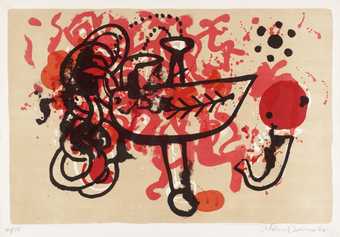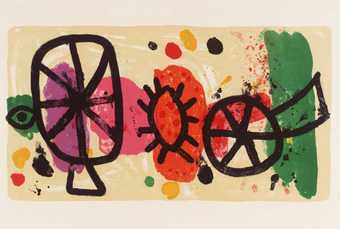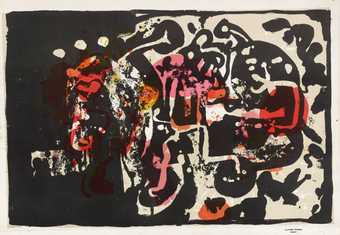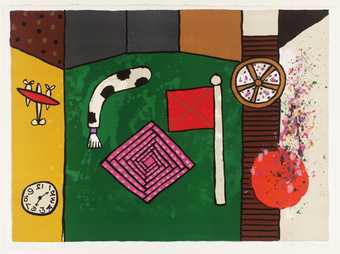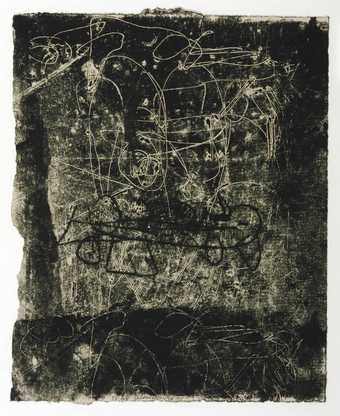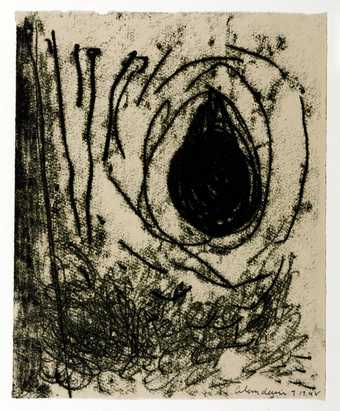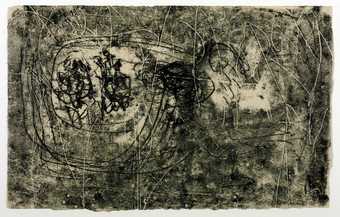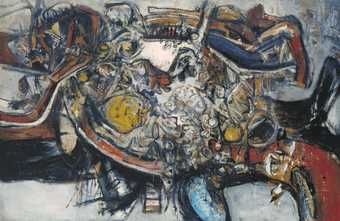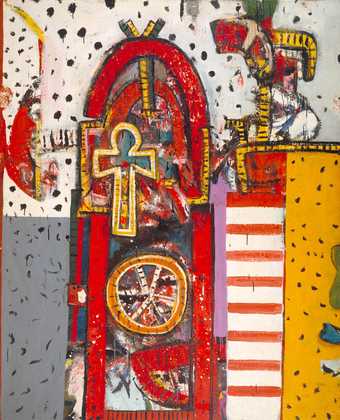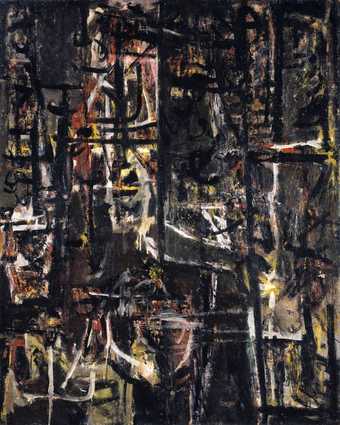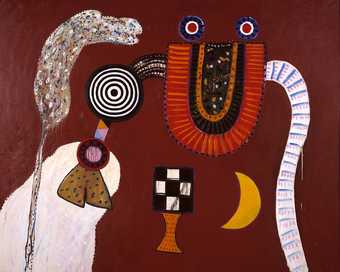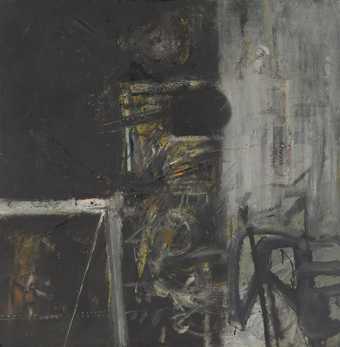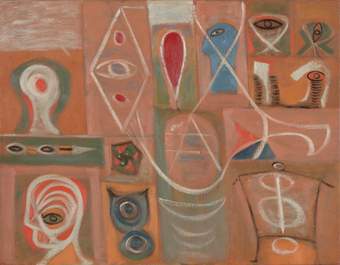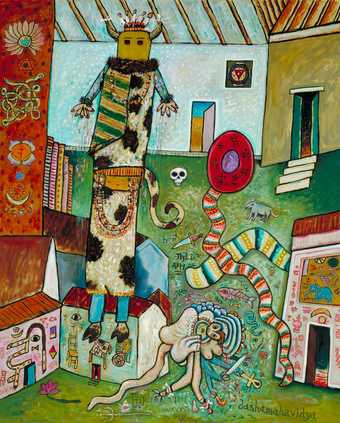
Not on display
- Artist
- Alan Davie 1920–2014
- Medium
- Oil paint on board
- Dimensions
- Support: 1530 × 1219 mm
- Collection
- Tate
- Acquisition
- Presented by E.J. Power through the Friends of the Tate Gallery 1973
- Reference
- T01748
Display caption
Davie’s paintings are characterised by a variety of personal pictograms, shapes and symbols that he has defined as ‘primordial’. He believes that they have ‘many and varied meanings’, which he leaves open to poetic interpretation and free association. Image of the Fish God has a totemic monumentality that evokes ancient cultures and shamanistic beliefs. The black form may be seen as figurative, and the central diamond is reminiscent of an all-seeing eye.
Gallery label, July 2012
Does this text contain inaccurate information or language that you feel we should improve or change? We would like to hear from you.
Catalogue entry
Alan Davie b.1920
T01748 Image of the Fish God 1956
Not inscribed.
Oil on hardboard, 6o¼ x 48 (153x 122.5).
Presented by E. J. Power through the Friends of the Tate Gallery 1973.
Coll: Purchased by E. J. Power from the artist.
Lit: Alan Davie, ed. Alan Bowness, London 1967.
Repr: Catalogue, vol.2, Documenta II, Kassel, 1959, p. 138 (not exhibited).
The donor, Mr E. J. Power, recalled (in a telephone conversation with the compiler) that he visited the artist at his studio in Rush Green, Hertfordshire, early in 1956, where he saw ‘three or four completed “Fish Gods” and several unfinished’. As far as he can remember he bought T01748 at that visit and Davie had already given the title to the series.
There are seven paintings entitled ‘Image of the Fish God’ which are all on board of the same dimensions, but three (collections of Stanley Seeger, Stedelijk Museum at Amsterdam, British Council) are horizontal in orientation; the three remaining vertical paintings belong to Gimpel Fils, the Hon. Anthony Montagu, and Gallery Blu, Milan ( ?). Except for T01748, all the paintings were numbered from 1-6. The artist wrote that ‘There has always been confusion about this series—up until now I thought there were only six.
‘I believe this was the first time I actually worked out a specific theme through a number of individual pictures. At that time I was doing many drawings “in series”.
‘I would put some 20 sheets of paper (different sizes) on the floor and with black oil (or gouache) I would make one mark on each (each mark related) 1-20. Then beginning at I again make another sign, or image, which also would be included in a variety of ways in the others.
‘In this way the series developed as a unit (not one at a time) and in the end I had 20 drawings. These 7 boards were actually re-incorporated in a series which included a number of drawings in black oil. They all developed together in a quite miraculous way.
‘I can’t remember how many drawings there are’. One drawing from the series (black oil on paper, 15 x 13¼. in.; Circulation Department, Victoria and Albert Museum, Circ. 342–1959) shows the central figure of the ‘fish god’ but with more obviously anthropometric features.
As with most of Davie’s titles ‘Image of the Fish God’ is a ‘poetic interpretation’ and ‘There is no conscious significance in the symbols’. The diamond shape had already been present in Davie’s ‘vocabulary’ of symbols for several years. But the right-angled figure ending in two points had not occurred previously, and has reappeared quite often in paintings since then: ‘Certain images reappear in my work— they become obsessive symbols but are never used consciously for any purpose or conveyance of specific meaning. Mainly, I feel, many of them are primordial symbols which have many and varying meanings at different times but unknown to mankind’.
The series was painted before Davie’s visit to the United States in March and April. For that year, 1956, there are over fifty large oils listed, more than double the number of paintings for the previous year. According to Bowness (op. cit. p. 172) he worked ‘very quickly’ and was ‘sure of what he wanted to paint’, freely incorporating techniques experimented with during the previous years such as in T01748 (and Stanley Seeger’s ‘Fish God’) standing up the painting—which was done flat on the ground, before it was dry, and allowing the very liquid paint to run freely down the board.
T01748 has been designated Opus 140A.
Published in The Tate Gallery Report 1972–1974, London 1975.
Explore
- abstraction(8,615)
-
- from recognisable sources(3,634)
-
- figure(2,270)
- non-representational(6,161)
-
- irregular forms(2,007)
- god(15)
- education, science and learning(1,416)
-
- psychology, Jung(29)
You might like
-
Alan Davie Celtic Dreamboat III
1965 -
Alan Davie Italian Image
1973 -
Alan Davie For the Hens
1968 -
Alan Davie Magic Picture No. 1
1977 -
Alan Davie Night Sky on a Holiday
1948 -
Alan Davie Interested Sperm Around an Egg
1948 -
Alan Davie Obscure Biological Function Surrounded by Nerve Impulses
1948 -
Alan Davie Birth of Venus
1955 -
Alan Davie Entrance for a Red Temple No. 1
1960 -
Alan Davie Sacrifice
1956 -
Alan Davie Entrance to a Paradise
1949 -
Alan Davie Fairy Tree No. 5
1971 -
Alan Davie Black Mirror
1952 -
Adolph Gottlieb The Alchemist
1945 -
Alan Davie Village Myths No. 36
1983

